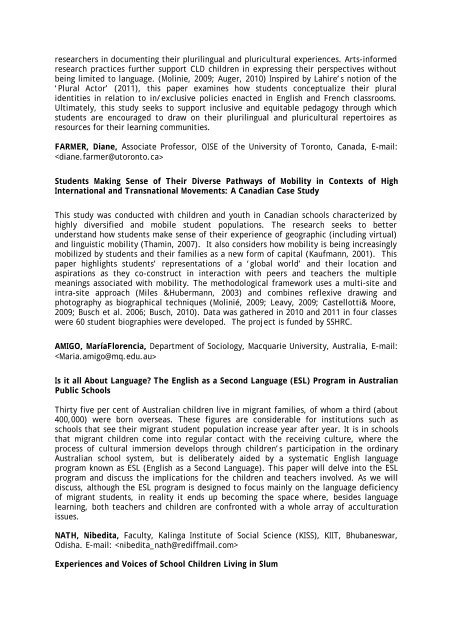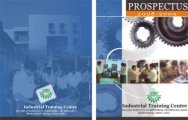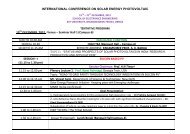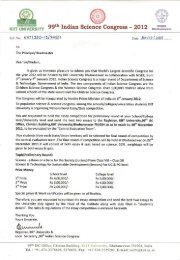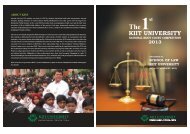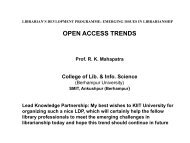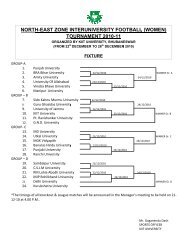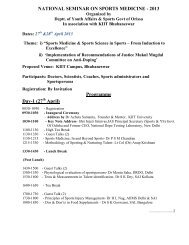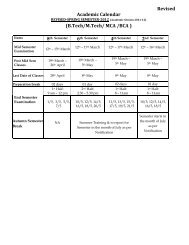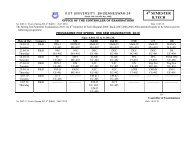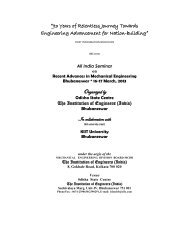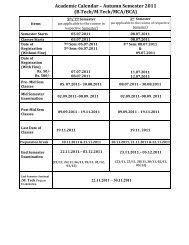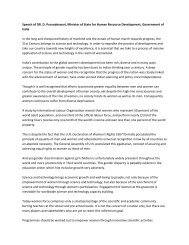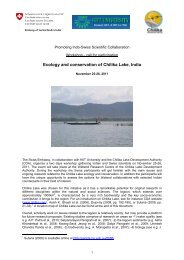PANEL ORGAN - KIIT University
PANEL ORGAN - KIIT University
PANEL ORGAN - KIIT University
Create successful ePaper yourself
Turn your PDF publications into a flip-book with our unique Google optimized e-Paper software.
esearchers in documenting their plurilingual and pluricultural experiences. Arts-informed<br />
research practices further support CLD children in expressing their perspectives without<br />
being limited to language. (Molinie, 2009; Auger, 2010) Inspired by Lahire’s notion of the<br />
‘Plural Actor’ (2011), this paper examines how students conceptualize their plural<br />
identities in relation to in/exclusive policies enacted in English and French classrooms.<br />
Ultimately, this study seeks to support inclusive and equitable pedagogy through which<br />
students are encouraged to draw on their plurilingual and pluricultural repertoires as<br />
resources for their learning communities.<br />
FARMER, Diane, Associate Professor, OISE of the <strong>University</strong> of Toronto, Canada, E-mail:<br />
<br />
Students Making Sense of Their Diverse Pathways of Mobility in Contexts of High<br />
International and Transnational Movements: A Canadian Case Study<br />
This study was conducted with children and youth in Canadian schools characterized by<br />
highly diversified and mobile student populations. The research seeks to better<br />
understand how students make sense of their experience of geographic (including virtual)<br />
and linguistic mobility (Thamin, 2007). It also considers how mobility is being increasingly<br />
mobilized by students and their families as a new form of capital (Kaufmann, 2001). This<br />
paper highlights students’ representations of a ‘global world’ and their location and<br />
aspirations as they co-construct in interaction with peers and teachers the multiple<br />
meanings associated with mobility. The methodological framework uses a multi-site and<br />
intra-site approach (Miles &Hubermann, 2003) and combines reflexive drawing and<br />
photography as biographical techniques (Molinié, 2009; Leavy, 2009; Castellotti& Moore,<br />
2009; Busch et al. 2006; Busch, 2010). Data was gathered in 2010 and 2011 in four classes<br />
were 60 student biographies were developed. The project is funded by SSHRC.<br />
AMIGO, MaríaFlorencia, Department of Sociology, Macquarie <strong>University</strong>, Australia, E-mail:<br />
<br />
Is it all About Language The English as a Second Language (ESL) Program in Australian<br />
Public Schools<br />
Thirty five per cent of Australian children live in migrant families, of whom a third (about<br />
400,000) were born overseas. These figures are considerable for institutions such as<br />
schools that see their migrant student population increase year after year. It is in schools<br />
that migrant children come into regular contact with the receiving culture, where the<br />
process of cultural immersion develops through children’s participation in the ordinary<br />
Australian school system, but is deliberately aided by a systematic English language<br />
program known as ESL (English as a Second Language). This paper will delve into the ESL<br />
program and discuss the implications for the children and teachers involved. As we will<br />
discuss, although the ESL program is designed to focus mainly on the language deficiency<br />
of migrant students, in reality it ends up becoming the space where, besides language<br />
learning, both teachers and children are confronted with a whole array of acculturation<br />
issues.<br />
NATH, Nibedita, Faculty, Kalinga Institute of Social Science (KISS), <strong>KIIT</strong>, Bhubaneswar,<br />
Odisha. E-mail: <br />
Experiences and Voices of School Children Living in Slum


